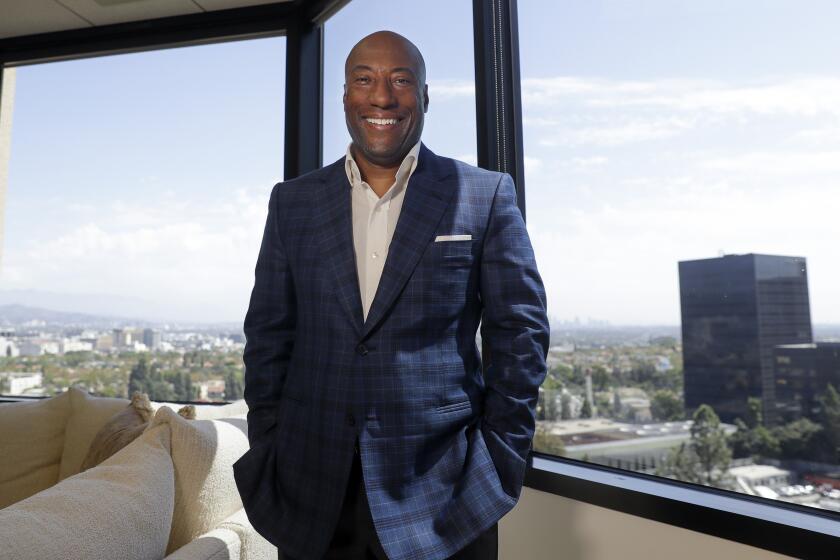Gold Is All Aglitter Again--but Look Hard Before You Leap
- Share via
Gold, the shiny metal that has inspired avarice throughout history, is getting a play again. The price of gold, which paused and retreated slightly on Tuesday, has jumped to more than $350 an ounce in recent days on reports that George Soros, a major global investor, has taken a big position.
Gold’s price was already gaining on exchanges in London and New York because of increased buying in China and East Asia, where newly prosperous farmers and city dwellers buy gold to display their riches and to hedge against inflation and currency devaluation.
Many experts also see fears of worldwide unrest spurring gold buying in Asia, Turkey and the Middle East. Traders don’t expect gold to spiral back to its January, 1980, peak of $850 an ounce. But analysts do suggest that it could get to $375 an ounce this year, a little higher next. It had bottomed out at about $326 an ounce March 10.
And there’s no denying the excitement in precious metals markets at the news that Soros has bought a 10% interest in Newmont Mining, the largest gold producer in North America. Soros bought the Newmont stake for almost $400 million from Sir James Goldsmith, a British financier who promptly announced that he was investing much of the proceeds in options on gold bullion.
So big money and smart people appear to be betting on gold. What should ordinary savers and investors do?
Ask questions. Who is George Soros and why should we pay attention to him? What is the rising gold price signaling about the U.S. and world economies? And most important, is gold a good investment for an individual’s portfolio?
Soros is interesting. Born in Hungary 63 years ago, he is principal manager and owner of the Quantum Funds, five global investment vehicles based outside the United States that he and associates have built over 24 years. Today Soros’ funds--which are not open to U.S. investors--hold portfolios reportedly worth $50 billion in securities, real estate and currencies worldwide.
He’s known for flamboyant success. Last year, Soros’ funds cleared a profit of more than $1 billion betting against the British pound, which devalued in August.
He has also made flamboyant mistakes. In 1987, when he published a philosophical book, “The Alchemy of Finance,” Soros predicted the October stock market crash, but he bought in too soon when stocks began to fall and ended up losing hundreds of millions of dollars.
One point in his book is worth noting: “Markets can influence the events they anticipate.” So declines in the U.S. dollar, which have worsened with increased foreign selling, could help cause rising inflation and higher U.S. interest rates.
Today Soros is betting on rising rates. Traders in government securities report that his funds are selling U.S. Treasury bonds short--making a bet that their value will fall as interest rates rise.
On the other hand, Soros is investing in real estate as well as gold. Earlier this year, he set up a $525-million real estate fund that, with borrowings, will swing $3 billion of investments into commercial real estate. It’s notable that he is said to be putting money in bedraggled Southern California real estate, as well as rising Mexican properties.
The pattern is suggestive. Soros is going into commodities and real estate and away from stocks and bonds. He’s not alone, says John Rutledge, a Greenwich, Conn., financial adviser who sees other big investors making similar moves.
“Inflation will stay down for six months more,” predicts Rutledge, who correctly called the disinflation of the ‘80s as an aide in the early Reagan Administration. “But guys like Soros are moving now.”
What’s happening is that concern is spreading, among investors here and abroad, that Clinton Administration policies will lead to stagflation--rising prices and stalled industry. Asians buying gold are forsaking the U.S. dollar, which usually is held as a store of value in many countries. “We’re at a turn in the gold cycle,” says analyst Vahid Fathi of Chicago’s Kemper Securities.
Still, that doesn’t necessarily make gold a good investment for individuals. Gold coins or bars pay no dividends and cost money to store and insure. In the last 10 years, gold mutual funds were down 23% while other funds multiplied in value.
Keep in mind that gold’s spectacular rise in the 1970s was exaggerated, a reaction to coming off 40 years of regulation at $35 an ounce. And remember that a rising price will bring forth more production from South African mines that become economic at higher ore prices.
Finally, note that Soros has not bought gold but shares of a substantial company, Newmont Mining, that mines gold in North America at $200 an ounce. If gold’s price stays where it is, Newmont makes a profit; if the price goes up, Newmont makes more profit. Soros is covered.
So what should an ordinary investor do? Keep your powder dry, watch real estate, be careful of bonds, selective among stocks--many of which can benefit from inflation.
And try to think like Soros, the son of a World War I prisoner of war who in “Alchemy of Finance” writes: “If I had to sum up my practical skills, I would use one word: survival. “
Gold, the Precious Predictor? After regulations on gold’s price and restrictions on U.S. ownership were lifted in the early ‘70s, gold took off. Often called an inflation hedge, it outran general price rises during most of the ‘70s, but declined most years of the ‘80s. Now experts wonder if its latest rise signals new inflation in the ‘90s.
Percentage change in average price of gold:
1971: 13.6%
1993 to date: 3%
Percentage change in the consumer price index:
1971: 4.4%
1993 to date: 3.9%
Source: Bureau of Labor Statistics, World Gold Council
More to Read
Inside the business of entertainment
The Wide Shot brings you news, analysis and insights on everything from streaming wars to production — and what it all means for the future.
You may occasionally receive promotional content from the Los Angeles Times.










